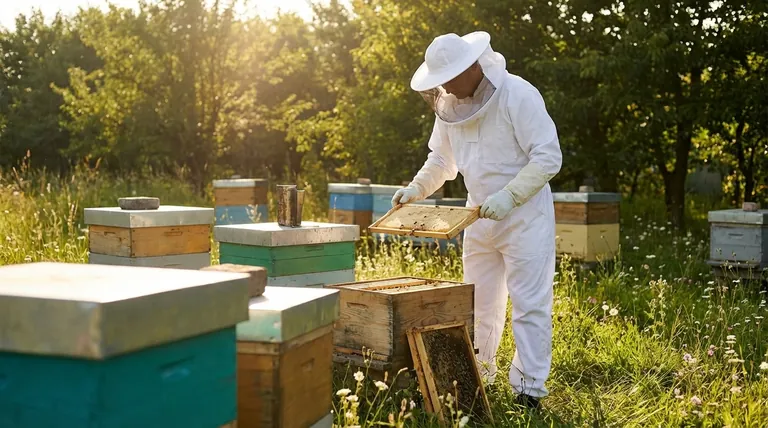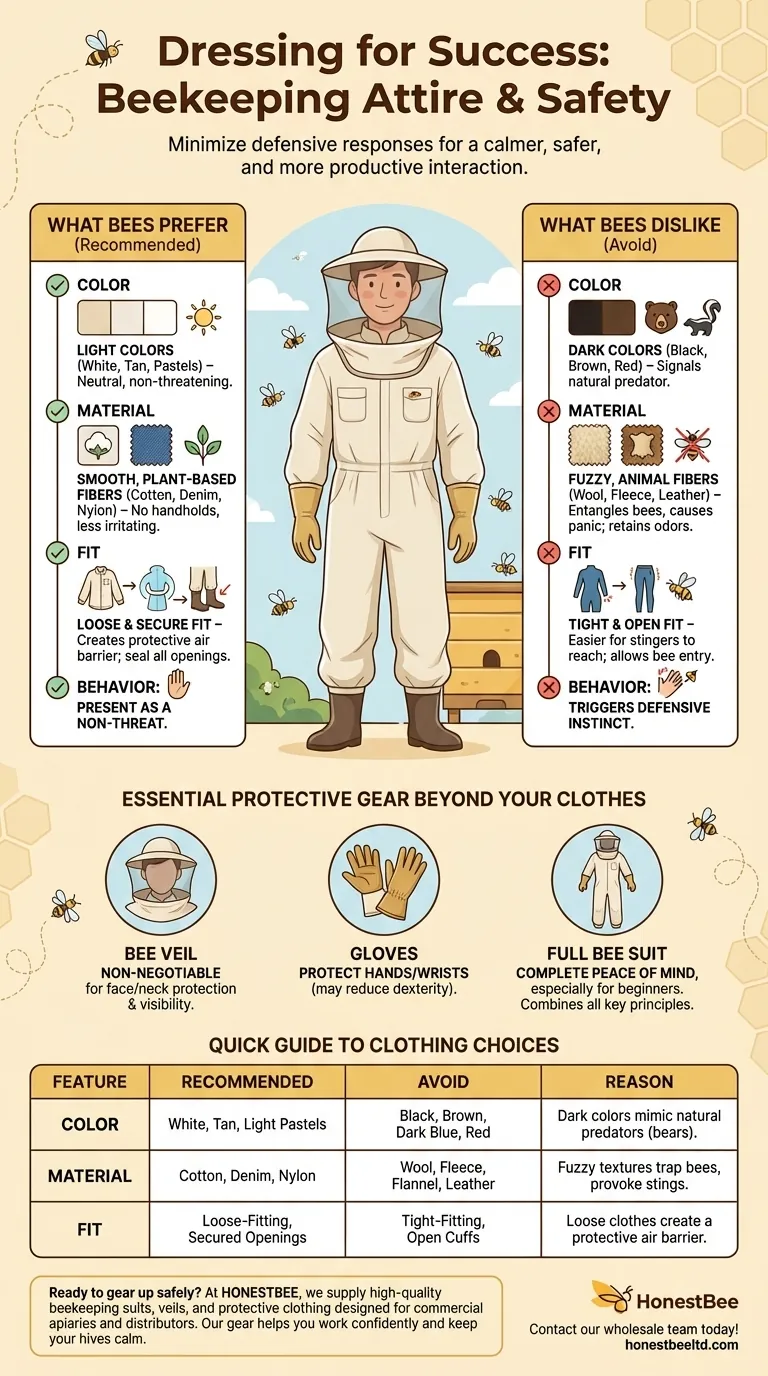For working with bees, the most suitable clothing is light-colored, smooth-textured, and made from plant-based fibers like cotton. Bees are instinctively defensive against dark colors, fuzzy materials, and animal fibers (like wool or leather), as these can signal the presence of a natural predator. Your clothing is the first line of communication with the hive, and the right choice promotes a calmer interaction.
Your primary goal in selecting beekeeping attire is not just to protect yourself, but to present yourself to the bees as a non-threat. The right clothing minimizes the hive's defensive response, leading to a safer and more productive experience for both you and the bees.

Why Your Clothing Choices Matter to Bees
Understanding a bee's defensive triggers is key to selecting the right gear. Their behavior is not malicious; it is a hardwired instinct to protect the colony from perceived threats.
The Critical Role of Color
Bees have evolved over millions of years to recognize and defend against natural predators like bears, badgers, and skunks. These animals are typically dark and furry.
As a result, bees are more likely to react defensively to dark colors such as black, brown, dark blue, or even bright red.
Conversely, white, tan, or other light pastels do not trigger this same alarm response. These colors blend more readily with the sky and flowers, appearing neutral and non-threatening to the hive.
The Problem with Texture and Material
Fuzzy or rough textures, like those found in wool, flannel, or fleece, can provoke bees. This is because these materials can easily entangle a bee's legs, causing it to feel trapped and panic, which may lead it to sting.
Furthermore, these fuzzy textures mimic the fur of a predator. Smooth materials like cotton, denim, or nylon provide no such handholds and are far less alarming. Clothing made from animal fibers, such as leather or wool, may also retain odors that bees find agitating.
The Importance of a Secure Fit
Beyond color and material, the fit of your clothing is a crucial safety component. Bees are explorers and will investigate any openings.
Your attire should be loose-fitting, which creates a layer of air between the fabric and your skin, making it harder for a stinger to reach you if a bee does become aggressive.
Most importantly, you must secure all openings. Tuck your pants into your boots and ensure your sleeves are sealed at the wrist. This prevents bees from crawling inside your clothing, which is a primary cause of stings.
Essential Protective Gear Beyond Your Clothes
While a long-sleeved, light-colored shirt and pants are a good foundation, they are not sufficient on their own, especially for beginners. True protection requires dedicated beekeeping gear.
The Non-Negotiable Bee Veil
The single most important piece of protective equipment is a bee veil. Your face and neck are particularly sensitive, and bees are often drawn to the carbon dioxide you exhale. A veil reliably protects your head while maintaining visibility.
The Function of Gloves
Beekeeping gloves, typically made of leather or thick canvas with long gauntlets, protect your hands and wrists. While they offer excellent protection, they can reduce dexterity, making it harder to handle frames gently. Some experienced beekeepers prefer not to use them for this reason.
The Option of a Full Bee Suit
For complete peace of mind, especially when you are starting out, nothing beats a full bee suit. These one-piece garments cover you from neck to ankle and incorporate a veil. They are designed with all the key principles in mind: they are light-colored, have a smooth finish, and feature elastic cuffs and ankles to seal out bees.
Making the Right Choice for Your Goal
Your choice of gear depends on your comfort level and experience.
- If your primary focus is maximum safety and confidence as a beginner: Invest in a full, ventilated bee suit. This removes any anxiety about stings and allows you to focus on learning to handle the bees calmly and gently.
- If your primary focus is routine inspection as an experienced beekeeper: A simple setup of a bee veil, light-colored denim or cotton work clothes, and optional gloves is often sufficient.
- If your primary focus is a quick, minimal hive check: At a minimum, always wear a bee veil to protect your face and head from any unexpected defensive behavior.
Dressing appropriately shows respect for the bees and allows you to work as a calm partner to the hive, not a threat.
Summary Table:
| Feature | Recommended | Avoid | Reason |
|---|---|---|---|
| Color | White, Tan, Light Pastels | Black, Brown, Dark Blue, Red | Dark colors mimic natural predators like bears. |
| Material | Cotton, Denim, Nylon | Wool, Fleece, Flannel, Leather | Fuzzy textures can trap bees and provoke stings. |
| Fit | Loose-Fitting, Secured Openings | Tight-Fitting, Open Cuffs | Loose clothes create a protective air barrier. |
Ready to gear up safely? At HONESTBEE, we supply high-quality beekeeping suits, veils, and protective clothing designed for commercial apiaries and distributors. Our gear helps you work confidently and keep your hives calm. Contact our wholesale team today to get the right protection for your operation!
Visual Guide

Related Products
- Cotton Beekeeping Suit and Round Hat with Veil Bee Keeper Protective Gear
- White Beekeeping Protective Suit and Hat with Fencing Veil for Beekeepers
- Professional Beekeeping Suit for Kids and Girls Childrens Bee Keeper Suit
- Heavy Duty Cowboy Beekeeper Hat with Visibility Veil Outdoor Professional Beekeeping Protective Gear
- Beekeeper Cowboy Hat and Veil for Beekeeping
People Also Ask
- Why is white the predominant color in bee suit designs? | Key to Hive Calm & Beekeeper Safety
- What should be considered regarding the color of beekeeping clothing? Ensure Your Safety and Keep Bees Calm
- What are the benefits of a fully ventilated beekeeping suit? Stay Cool and Protected in Hot Climates
- Do beekeeping suits completely prevent stings? Maximize Your Apiary Safety with the Right Gear
- Why is a jacket with a hat veil recommended for beekeepers? Essential Protection for Your Face and Neck



















